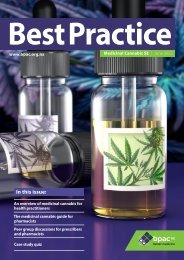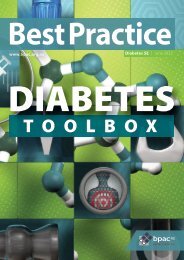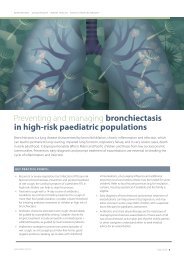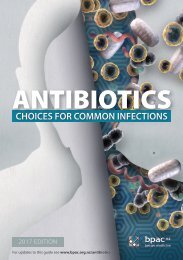You also want an ePaper? Increase the reach of your titles
YUMPU automatically turns print PDFs into web optimized ePapers that Google loves.
A glucagon-like peptide 1 (GLP-1) receptor agonist<br />
(injectable, not funded * )<br />
* PHARMAC have announced that, after consultation, a sodium-glucose<br />
co-transporter 2 (SGLT2) inhibitor, empagliflozin, with and without<br />
metformin, will be funded from 1 December, <strong>2020</strong>. Dulaglutide, an<br />
injectable glucagon-like peptide 1 (GLP-1) receptor agonist, will also be<br />
funded once the medicine has Medsafe approval. Both treatment options<br />
will be funded for patients meeting Special Authority criteria.<br />
Clinicians and patients can jointly decide which of these<br />
medicines to use, taking into account any contraindications,<br />
cardiovascular comorbidities, risk of hypoglycaemia, effects<br />
on weight, medicines interactions, adverse effects and cost<br />
(Table 1). 19 A SGLT-2 inhibitor or GLP-1 receptor agonist is<br />
the preferred second-line pharmacological treatment in<br />
international guidelines for people with type 2 diabetes who<br />
are at high risk or have established CVD, chronic kidney disease<br />
or heart failure, or where there is a need to minimise weight<br />
gain or promote weight loss. 19, 20 However, these medicines are<br />
not currently funded in New Zealand.<br />
People who have contraindications to using metformin,<br />
or who trial metformin but are unable to continue use due<br />
to adverse effects, can initiate any of these other options<br />
alone. 20<br />
Triple therapy: insulin is typically initiated if treatment<br />
with two oral medicines is insufficient<br />
If further escalation of treatment is required, insulin can be<br />
initiated or three oral medicines used in combination. The<br />
addition of insulin is the typical course of action and should<br />
be considered for patients with a HbA 1c<br />
level > 65 mmol/mol<br />
despite lifestyle interventions and treatment with two oral<br />
anti-diabetic medicines. 22 N.B. A GLP-1 receptor agonist is<br />
preferred to insulin for treatment intensification in international<br />
guidelines. 19<br />
Vildagliptin: the new kid on the block<br />
Vildagliptin is an oral dipeptidyl peptidase (DPP-4)<br />
inhibitor approved for the treatment of type 2 diabetes.<br />
Vildagliptin has been fully funded in New Zealand since<br />
1 October, 2018. Since it was funded, 45,662 people in New<br />
Zealand have been dispensed this medicine. Vildagliptin<br />
prescribing increased steadily through 2019 and the first<br />
half of <strong>2020</strong>; it is likely to match the rate of prescribing for<br />
sulfonylureas later in <strong>2020</strong>.<br />
N.B. The spike in dispensings in March <strong>2020</strong>, followed by<br />
the drop in April, <strong>2020</strong>, reflects New Zealand moving into<br />
COVID-19 pandemic Level 4.<br />
N.B. Liver function should be assessed before initiating<br />
vildagliptin treatment and monitored every three months<br />
for the first year. 21<br />
For further information on prescribing vildagliptin,<br />
see: https://bpac.org.nz/2018/vildagliptin.aspx<br />
25 000<br />
Sulfonylureas<br />
Number of dispensings<br />
20 000<br />
15 000<br />
10 000<br />
5000<br />
0<br />
Vildagliptin<br />
Pioglitazone<br />
1 2 3 4 5 6 7 8 9 10 11 12 1 2 3 4 5 6<br />
2019 <strong>2020</strong><br />
Figure 1: The number of dispensings of vildagliptin (and formulations), sulfonylureas (glibenclamide, gliclazide and<br />
glipizide) and pioglitazone dispensed from community pharmacies in New Zealand from January, 2019 to June, <strong>2020</strong>.<br />
www.bpac.org.nz<br />
Best Practice Journal – SCE Issue 1 11









